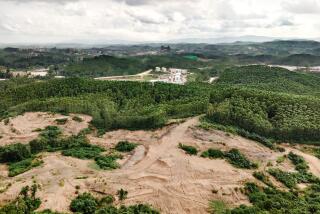Indonesia, firm to share bill for mudflow
JAKARTA, INDONESIA — Almost a year after a massive flood of mud began, the Indonesian government is set to pay a share of the massive bill, pledging at least $275 million to repair the damage from the disaster that just won’t stop.
Thick muck has spewed over hundreds of families’ homes as well as their rice fields, factories and roads since May, when a natural-gas drilling project went wrong in Sidoarjo, which, like Jakarta, the capital, is on the island of Java.
The rupture has belched out more than 1 billion cubic feet of mud, forming a hot sludge lake that covers several square miles. As flummoxed engineers struggle to stem the gray tide, the national government announced this week that it budgeted the $275 million to help deal with the crisis. Opponents in parliament say they will try to block the payment. They want Lapindo Brantas Inc., the company blamed for the disaster, to foot the entire bill.
The money will fund the rerouting of a railway line, highway and gas pipeline buried under the mud and the purchase of land on which to rebuild the destroyed infrastructure.
By decree of Indonesian President Susilo Bambang Yudhoyono, Lapindo Brantas is responsible for compensating victims who lost land and homes up until March 22.
The company, which struck an underground aquifer while drilling for natural gas, must also cover the cost of stopping the mud and building a mile-long canal to channel the sludge into a nearby river.
But the government is stuck with bills for any damage after March 22.
Lapindo Brantas says it has thus far paid just over $1 million to compensate farmers for the loss of 725 acres of rice paddies inundated by the mud.
Less than 5% of the 15,000 victims -- who come from the 2,500 families who lived in eight villages inundated by the mud -- have received compensation because they have had difficulty proving they own their land, said Muhammad Syaiful Aris, head of a local legal aid agency. Aris’ agency is among those suing the government and gas company on behalf of residents claiming damage.
Because Lapindo Brantas is buying the land now covered by mud, villagers have been told they must provide official ownership certificates, which most don’t have, Aris said by phone from Surabaya, near Sidoarjo and about 420 miles east of the capital.
“About 85% of the victims inherited their land based on traditional agreement, which is written only in village records,” he said. “If Lapindo demands a certificate, it has to be one registered from the national land agency.”
Villagers who get money may receive more than their land was worth, but the funds don’t cover other significant losses, including psychological injury, the lawyer added.
“Some people lost their businesses, or even their hope for the future,” Aris said. “Some students can’t go to school. And in the larger context, there are factories that are closed, so their employees can’t work.”
A dike around the sludge lake burst again Tuesday, and the mudflow is threatening to swamp another village. The damage inflicted by the runaway muck is expected to take years to repair, and the final bill could top $770 million, according to government estimates.
Engineers are working round-the-clock to plug a hole gushing mud and gas with hundreds of concrete balls chained together and each weighing up to 175 pounds.
Indonesians waiting for the catastrophe to end are losing hope that the balls will work. A previous effort to seal off the steaming vent led to an eruption in another spot and the flooding continued.
After a team of experts failed to stem the tide, Yudhoyono named a replacement for the task: the national Mudflow Mitigation Agency, headed by a retired army general.
Aris said the retired general’s appointment worried him. Indonesia’s fragile democracy is only 8 years old, and the military is still widely seen as corrupt.
“Does he have enough technical skill and knowledge?” the lawyer said. “We are afraid that he’s going to pursue a repressive approach to solve the problem.”
More to Read
Sign up for Essential California
The most important California stories and recommendations in your inbox every morning.
You may occasionally receive promotional content from the Los Angeles Times.










